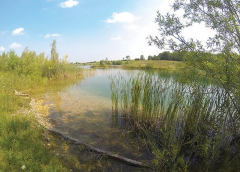Thousands of rainbow trout teem through sparkling waters at an aquaculture facility run by Stoller Canada at McMillan Pond in the Aberfoyle area of south-central Ontario, about 40 minutes from Toronto.
Looking at the pristine habitat the fish enjoy, you’d never guess that, just years earlier, the site was a Canada Building Materials (CBM) aggregates sand and gravel pit supplying vast volumes of material for construction across Canada.
Transformation of former aggregates operations into lakes and farmland is just one of the ways that CBM and Prairie Material, sister companies from Votorantim Cimentos’ North American operations (VCNA) are keeping its commitment to care for the earth and its resources while providing top-quality products for construction around the world.

Taking Shape
John Moroz, president and general manager of aggregates for VCNA, explained how the award-winning McMillan Pond restoration took shape.
“This area was a 100-acre site mined from the 1980s through 2004,” Moroz said. “In fact, the gravel from this pit built much of Mississauga and many of the local roads.” After extracting all available rock, the company was left with a site that included a 60-acre (24-ha) man-made lake.
The original rehabilitation, completed in 2008 under the direction of Votorantim Cimentos’ Aggregates Land and Resources team, involved shaping wetlands and shoreline, planting trees and spreading native seeds.
But it takes more than just water to establish a thriving ecosystem. Though beautiful, the lake was sterile – and without further intervention, it wouldn’t have supported productive aquatic life for at least 20 years.
By 2013, when Stephen May, western region lands manager for CBM’s Aggregates came on board, the planted wetland was in real trouble.
“Apparently, the groundwater moving through the site had such low nutrient levels that the wetland was starving,” May explained.
As an avid fisherman and former Ministry of Natural Resources employee with strong interests in land rehabilitation and aquaculture, May thought that stocking fish would jump-start the renewal of the waters.
“Trout could do fine here – they can live in a low-nutrient environment and their waste would eventually help to increase the nutrients,” he remembered thinking.
AgriMarine, an aquaculture company based in British Columbia, proposed a broader plan in which new technology could support a commercial aquaculture facility that would provide crucial nutrients for the lake’s revival as well as capture excess waste to be turned into fertilizer.
Because the plan would generate a cash crop – the trout – and fish waste for recycling into fertilizer, it would also be cost-neutral, possibly even generating revenue. Votorantim Cimentos management gave the thumbs-up and AgriMarine began implementation in 2014.

How it Works
The McMillan Pond system is a marvel of modern aquaculture. Trout are contained in a floating raceway system made of PVC, where water is pumped through the system using an energy efficient airlift pump that simulates a stream experience for the fish. Much of the fish waste dissolves in the pond and fertilizes the lake ecosystem.
A significant portion of waste produced by the fish is also captured and pumped into biobags, de-watered and processed. “We collect and process the excess fish nutrient and use it to enrich the surrounding wetlands, where it fosters the growth of plants and microorganisms,” May noted.
Fishing Experts Guide Project
The McMillan Pond aquaculture facility is now managed by Stoller under the expert direction of biologistWayne Izumi, brother of famed fishermanBob Izumi, star of Bob Izumi’s Real Fish Show.
2015 was the first full year of operation, yielding nearly 60 tons (54 tonnes) of fish and the capture of almost 6 tons (5.44 tonnes) of waste that can be composted to create rich fertilizer.
Most of the harvested trout go to a smokehouse 45 minutes away. Izumi’s staff closely monitors conditions in the lake, channeling key data back to Votorantim Cimentos’ CBM Aggregates team.
Izumi said the trout are greatly accelerating the process of creating a healthy lake.
“We are seeing positive response in the amount of vegetation, and the biomass of minnows and insects rising,” he reported. “Now that it is established, the challenge is how to make it work the best way possible.”
“The data is as valuable to us as the rent that Stoller pays for use of the site,” said May. “Wayne tracks all results closely so we can gradually develop best practices for lakes at other former aggregate sites. For example, we want to know our nutrient calculations are on track so we don’t over-fertilize the waters. Also, we want to know how many fish the operation can produce without upsetting the ecological balance.”

